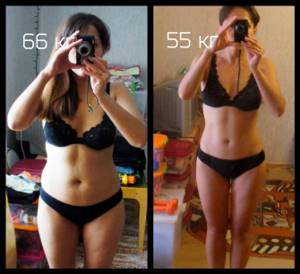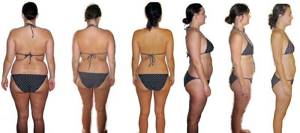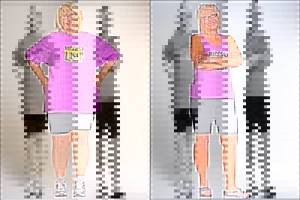We must not forget that losing weight is a process associated not only with diets, but also with proper nutrition. Do not forget that the faster you lose weight, the faster you will gain back those extra pounds. Let's remember what you need to lose weight? That's right: sports or diet, but physical activity is not as important as proper and balanced nutrition. Today, on the contrary, we will find out whether it is possible to lose weight without following strict diets and without restricting yourself in food. We would like to warn you right away that losing weight without a diet will be much slower than with it. Some claim that they know how to lose weight without a diet in a month, but at the end of each such statement you are offered to buy either a miraculous weight loss belt, or magic pills, or in general weight loss products that, contrary to the laws on digestion, will help you lose weight. We are not interested in trying to sell you something, so let's discuss the process of losing weight without changing your diet.
If you are really interested in how to lose weight without a diet in a month, you will have to make some calculations.
Namely, how many calories you need to maintain the vital functions of the body. The calculation formula is not difficult to find, so we will not take up your precious time and look at the example of a girl with a height of 170 cm, a weight of 70 kg and a sedentary lifestyle. She needs 1700 kcal to maintain her weight.
In order to lose weight, you need to consume no more than 1200 kcal. That is, create a calorie deficit.
To do this, you can either eat less (try an experiment and eat 1200 kcal for just one day), or exercise. In order to “burn” 500 kcal, you will need to walk 8 km. Do you agree? Or simply not eat a small piece of cake. It's equivalent. You see how much easier it is to simply deny yourself a small pleasure than to try to burn the result.
Moreover, we doubt that you will be able to lose weight without a diet in a month, since this is a very short period of time for losing weight on a strict diet and exercise, not to mention losing weight while maintaining your current diet. The point is that you should understand the difference between proper nutrition and a diet. No one is forcing you to starve, just eliminate bread, sweets and overeating, that’s all, and the process of losing weight will go very quickly!
Why does a person get fat?
Excess weight is gained “slowly,” but over many years of such gain, the scale shooter at the morning weigh-in makes the “owner” of such a body less and less happy. It’s quite understandable to want to lose extra pounds – it’s better for your health, and your appearance is more aesthetically pleasing.
A person gets fat for the following reasons:
- With a slow metabolism (metabolism).
- Hormonal imbalances.
- Slagging of the body.
- Due to genetic reasons.
- Physical inactivity (passive lifestyle) and many other reasons.
What is “safe weight loss”?
Losing weight can be called safe if:
- As a result, the percentage of body fat decreased. Body fat itself has a negative impact on health.
- Hunger and energy levels changed slightly. There is no hormonal imbalance.
- Feeling better.
- No eating disorders (EDs).
- A person likes the way his body looks.
- Resistance to overeating has appeared.
- Food addiction and cravings for certain types of food have decreased.
Any too fast or extreme weight loss is stressful for the body, and will certainly lead to “rebound syndrome” in the form of excess weight gain.
Lose weight by 10 kg or more in a month
Lose 10 kilograms in 1 month - is this realistic, many people ask, asking such a question in search engines and asking nutritionists. Moreover, without harm to health and at home, since not everyone wants to go to the gym for a number of reasons:
- Distance from place of residence.
- Expensive subscription.
- Various complexes that an overweight person experiences when being among people who are not burdened with such a problem.
- Reluctance to train around people.
Not everyone can afford a coach, which they might need at least at first.
Many people ask how you can lose 20 kilograms in 2-3 months and how hard it is.
In order to achieve such a result, of course, one diet or one sport will not be enough - it is more effective to combine both disciplines. Even the first 10 kg per month for most people losing weight is difficult to lose, let alone the remaining 10. If you keep a strict diet, then you will have neither strength nor nerves left for sports. If you exercise to the point of exhaustion, an exorbitant appetite will come. So the best way is physical activity combined with a balanced diet.
Calorie counting
To track your weight loss process, you need to keep a food diary. There are tables of calories and BJU (proteins, fats, carbohydrates) foods, which make it easier to track your diet. It is important to know the exact weight of the portion in order to correctly count calories. To lose weight and stay healthy, you need to consume from 22 to 26 kilocalories per 1 kg of weight. We multiply the number of calories by our own weight - we get the daily requirement. In this case, the body should receive 2 - 3 g of protein per 1 kg of weight, 2 - 3 g of carbohydrates, 1 - 2 g of fat. We multiply the indicators by your own weight, now you can find out how many calories you should consume daily. Calculating calories is simple:
- 1 g of protein contains 4 kcal;
- 1 g carbohydrate – 4 kcal;
- 1 g fat – 9 kcal.

The benefits and necessity of physical activity
In order to lose weight by 5, 10 kg. quickly and effectively at home, you will also need physical activity. Strictly speaking, any balanced diet without one, if not self-deception, is not a completely rational approach to business.
Just as it is hardly possible to lose weight without a diet and get rid of your own belly, it is also unlikely to lose weight quickly without the help of physical activity in all its forms:
- Run.
- Aerobics.
- Fitness.
- Pilates.
- Stretching.
- Callanetics.
- Yogi.
- Exercises called "plank".
- Bodybuilding, etc.
At home, it is quite enough to have a simple jump rope, small dumbbells, a bar built into the door and some simple devices like a fitball.

Simple exercises useful for the task at hand and overall health:
- Squats. This helps to work the legs and buttocks.
- Tilts. A great kick to the stomach.
- Mahi. This will also allow you to work your legs.
- Push ups. A universal exercise for many muscle groups, with the main emphasis on the arms. If the student is unable to do push-ups from the floor, then this can be done from a chair, chair, or even from a wall. Anyone can do this last exercise.
If you train with dumbbells for different muscle groups, it is better to work with small weights and do more repetitions - this way fat is burned more effectively.
The main thing in this matter is a positive attitude and belief in your own success.
If you don’t have a particular desire to run, and your weight doesn’t allow it yet, you can start with walking, preferably at a pace slightly higher than a walking one.
As for the jump rope, this simple equipment is absolutely indispensable, since with its help it is possible to remove fat from all parts of the body, including legs, arms, buttocks, face, etc. The main thing is to consult a doctor before you start exercising, preferably with sporty. And we must remember that overtraining can cause a lot of harm to the heart. Everything is good in moderation!
How many kilograms can you lose weight
Many people who want to lose weight, with bated breath and impatience, as they say, surf the Internet in the hope of finding a miracle diet or magical exercises that will allow them to lose 15, 20, 25, 30 and even 50 kg. per month. Or, at the very least, lose 30 kg. in 3 or 4 months at home.
Do not forget that fat has been building up for years, or even decades, due to improper (irregular) nutrition, physical inactivity and too much time spent in the kitchen in close proximity to the “native” refrigerator.
But there always comes a moment when you need to stop near the mirror after a shower and critically examine your body for unaesthetic “accumulations” in various parts of the body.
It is quite possible to lose 5 or even ten kilograms in a month, even 20, and more is possible. But will this be right in relation to one’s own health - that is the question.
Recently, TV has often shown all sorts of shows that demonstrate the miracles of losing weight in the shortest possible time. But, as they say, miracles do not happen, and this requires not only painstaking, but also simply hellish work, which includes both a diet and huge, sometimes prohibitive loads.
It’s worth weighing everything up and wondering when was the last time you went to the gym and whether you can give up your favorite baked goods, fatty sausages or beer, consumed in huge quantities every weekend. In order to achieve such fantastic results, you need an extraordinary will - and at the show, people driven to despair, and those who came to lose the hated kilograms (even dozens of them!) Not everyone can withstand such a race and leave home without a sip.
And even if someone has achieved their desired goal, they will face another, no less severe test - to maintain their “correct” weight without breaking down by overeating after long periods of food restrictions.

Many experts say that safe weight loss is a maximum of 3 kg. per month. So everyone should understand for themselves what results they can realistically expect and, probably, it is better to lose 10 kg. in 2, 3, or even 4 months, painless for your own psyche and safe for your health, rather than forcing events with a risk to your health.
And having lost, say, 20 kg. per year, a person receives simply a magnificent result, worthy of imitation, even envy.
Who is losing weight and how much?
Different people lose weight in different ways: some faster, some slower. This depends on the following reasons:
- Genetics.
- Metabolism (metabolism).
- Intensity and type of physical activity.
- Proper nutrition. Not everyone sticks to their diet conscientiously; some simply break down. No need to overuse salt!
- Compliance with drinking regime. It would seem that the more water a person drinks, the more he will weigh - no, the liquid consumed in the amount of one and a half to three liters (depending on one’s own weight) helps remove excess water from the body and removes swelling.
- Maintaining a sleep schedule. You need to sleep at least 7-8 hours.
A positive attitude and faith in yourself and your own strengths give a lot.
A person, even without doing physical exercise, can lose weight simply by eating the “right” foods, of course, in different ways: some by 6-7 kg, and some by 8-13 for the same period, despite equal conditions.
People with a lot of weight lose the first kilograms quite quickly.
A person who weighed, for example, 160 kg before taking care of himself. will lose his first 30 kg. much faster than someone who had their own weight before classes, say, 98 kg. And for someone who was much thinner, it will be much harder to lose those extra pounds.
Records of weight loss with strict diets
History knows - and the latest - examples of losing weight by a huge number of kilograms. Here they are:
- Manuel Uribe (Mexico). He weighed not much, not less, but 587 kg and was considered almost the fattest man in the world. He not only could not move, but even get out of bed. In seven years of a protein diet specially designed for him, he lost 400 kg.
- David Smith (America). His weight reached 285 kg. and the situation became, without increasing, critical. Thanks to special exercises and a diet designed for him, he began to lose 7 kg. monthly. In total, he managed to lose 180 kg.
- Rosalie Bradford (America, Pennsylvania). This woman even managed to “be” a Guinness record holder - once because of her huge weight of 544 kg, and on the second thanks to the fact that she lost 415 kg. in six years.
- Carol Wright, weighing 200 kg, lost 130 kilograms in 2 years thanks to fitness and a balanced diet.
History knows many similar examples, but it would be naive to believe that all these people easily achieved such results - without nervous breakdowns, as well as some deviations from diets.
Advice from nutritionists
The quieter you go, the further you'll get
Experienced nutritionists advise losing weight gradually. If you lose weight quickly, your health may deteriorate and it will be difficult to maintain the weight. It is optimal to lose 1 kg per week.
Water is your best friend
On average, a person consists of 70% water, so this is the main component of a healthy lifestyle. In the morning on an empty stomach, be sure to drink a glass 20-30 minutes before meals. The daily norm is 1.5-2.5 liters of clean water, not counting tea, coffee, juice, soups.
Regime is the key to success
Evenly distributing food intake throughout the day will prevent the body from starving. Compliance with diet and sleep will ensure vigor and high performance for a long time.
Replacing harmful foods with healthy ones
Completely giving up your favorite treats can lead to stress, and replacing them is a way to trick the body into getting used to PN.
For example, replace white flour with whole grain flour, sugar with sweetener or honey, buy whole grain or yeast-free bread instead of regular bread, and diet mayonnaise can be easily prepared by mixing sour cream, mustard and lemon juice.
Strict diets: benefit or harm
It is generally accepted that a strict diet is the most effective option for rapid weight loss, and it is completely safe for health. However, something else happens: some little-tested technique can lead to the most tragic consequences, which entail not only poor health, but even weight gain.
A strict diet involves a certain method where the daily diet does not exceed seven hundred (or even 500) calories. This leads to weight loss of a kilogram per day, or even more. Minuses:
- As a result, a deficiency of vital microelements occurs.
- The condition of hair, nails, and skin deteriorates.
- Violation of water balance, which retains water in the body.
- There is a high risk of gastrointestinal (gastrointestinal) diseases.
- Kidney diseases, etc. may appear.
All this threatens, in the end, at best, with a return to the previous weight, but most often the weight will increase by one and a half times. In addition, a person will forever be disappointed in the benefits and effectiveness of any diet, as a result of which he will become irritable and unsure of himself.
We should not forget that fat is far from the main cause of excess weight. Water and clogged intestines play a significant negative role in this.
To prevent a mono-diet from becoming a cause for illness and nervous disorders, it is better to seek qualified and useful advice from a nutritionist.
Therefore, using simply a balanced diet, exercise, proper drinking regimen and proper rest, you can achieve considerable results. And forced weight loss using various mono-diets, even if approved by a doctor, should not last more than one week, and not two months, as some try to practice.
Common mono-diets: kefir, water, buckwheat, apple, etc.
And you also need to remember one golden rule: it’s not enough to lose weight, it’s important to maintain it without losing your health!

Decide on a weight loss plan
In order to lose weight and, more importantly, maintain the results, you need to stick to a specific plan.
If you have just started this process and have had unsuccessful attempts to lose weight in the past, then you should try to seek help from specialists. Consult a nutritionist to help you develop a healthy diet that you can stick to for a long time and that will help you overcome bad eating habits.
A nutritionist's job is to help you overcome eating disorders, learn to control portions, and avoid large amounts of sugar, salt and saturated fats - the causes of heart disease and diabetes.

Lose weight for a woman or girl
Most women and girls want to lose weight: some by 3 kg, and some by all 10. However, this also applies to teenagers - and a 14-year-old girl may need this, since she too may have such problems.
First of all, you need to pay attention to problem “female” areas:
- Buttocks.
- Hips.
- Waist.
- Legs.
- Stomach.
This does not mean that you should not pay attention to your hands, face and other parts of the body. All of the above should have a decent appearance for representatives of both sexes, but it is women who are jealous of these zones, because this is what shapes their silhouette and so attracts men.
The buttocks, hips, back of the thigh, bringing the muscles and waist into proper shape (in addition to the jump rope) lead to:
- Squats.
- Stiff-legged deadlifts with light dumbbells (or even one), Romanian and sumo deadlifts.
You shouldn’t be afraid of all these deadlifts, believing that a woman’s figure will become a man’s in a month - for this you need to work too hard, using a barbell with heavy weights.
Before starting such training, you should consult your doctor.
You shouldn’t discount morning jogging, exercise, and various energy-consuming exercises. A contrast shower is also useful. As for a balanced diet, it is universal for everyone, regardless of gender.
All this can be successfully done at home, but deadlifts should be done at least at first under the supervision of a trainer.
Remove the hated belly
This problem area worries not only girls and women, but also many men. A large, saggy belly is an unesthetic and harmful phenomenon. What is the harm and danger:
- Accumulation of internal fat.
- Obesity.
- Dysfunction of the digestive organs.
- Clogged intestines.
- Diseases of the liver, stomach, bladder.
- Poor metabolism.
- Signal for the occurrence of endocrine and cardiovascular diseases.
This is not the entire list of supposed diseases, so you need to get rid of such a problem area first.
Everything is already clear with a balanced diet, but the exercises will be somewhat specific, although for the most part they are familiar from school physical education lessons. Since the abdominal muscles bear almost no load in everyday life, it is necessary to force it on them. Exercises:
- Working out the press. It is divided into the study of its upper and lower parts. “Treated” by lifting the torso and lifting the legs, respectively.
- You need to practice retracting your stomach in any suitable case. You should also straighten your shoulders.
- Do all kinds of exercises to twist the torso, thus working the oblique abdominal muscles.
And a few more useful tips: chew food thoroughly, ensure proper digestion to avoid constipation, don’t be nervous, drink plenty of water.











